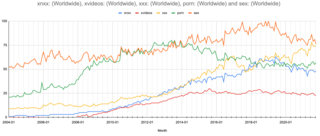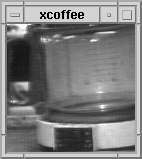Spyware is any software with malicious behavior that aims to gather information about a person or organization and send it to another entity in a way that harms the user by violating their privacy, endangering their device's security, or other means. This behavior may be present in malware and in legitimate software. Websites may engage in spyware behaviors like web tracking. Hardware devices may also be affected.

A webcam is a video camera which is designed to record or stream to a computer or computer network. They are primarily used in video telephony, live streaming and social media, and security. Webcams can be built-in computer hardware or peripheral devices, and are commonly connected to a device using USB or wireless protocols.

Virtual Network Computing (VNC) is a graphical desktop-sharing system that uses the Remote Frame Buffer protocol (RFB) to remotely control another computer. It transmits the keyboard and mouse input from one computer to another, relaying the graphical-screen updates, over a network.

The Department of Computer Science and Technology, formerly the Computer Laboratory, is the computer science department of the University of Cambridge. As of 2023 it employed 56 faculty members, 45 support staff, 105 research staff, and about 205 research students. The current Head of Department is Professor Alastair Beresford.
A webcast is a media presentation distributed over the Internet using streaming media technology to distribute a single content source to many simultaneous listeners/viewers. A webcast may either be distributed live or on demand. Essentially, webcasting is "broadcasting" over the Internet.

In computer networking, port forwarding or port mapping is an application of network address translation (NAT) that redirects a communication request from one address and port number combination to another while the packets are traversing a network gateway, such as a router or firewall. This technique is most commonly used to make services on a host residing on a protected or masqueraded (internal) network available to hosts on the opposite side of the gateway, by remapping the destination IP address and port number of the communication to an internal host.

Web conferencing is used as an umbrella term for various types of online conferencing and collaborative services including webinars, webcasts, and web meetings. Sometimes it may be used also in the more narrow sense of the peer-level web meeting context, in an attempt to disambiguate it from the other types known as collaborative sessions. The terminology related to these technologies is exact and agreed relying on the standards for web conferencing but specific organizations practices in usage exist to provide also term usage reference.

James Quentin Stafford-Fraser is a computer scientist and entrepreneur based in Cambridge, England. He was one of the team that created the first webcam, the Trojan room coffee pot. Quentin pointed a camera at the coffee pot and wrote the XCoffee client program which allowed the image of the pot to be displayed on a workstation screen. When web browsers gained the ability to display images, the system was modified to make the coffee pot images available over HTTP and thus became the first webcam.

The Hyper Text Coffee Pot Control Protocol (HTCPCP) is a facetious communication protocol for controlling, monitoring, and diagnosing coffee pots. It is specified in RFC 2324, published on 1 April 1998 as an April Fools' Day RFC, as part of an April Fools prank. An extension, HTCPCP-TEA, was published as RFC 7168 on 1 April 2014 to support brewing teas, also as an April Fools' Day RFC in error 418.

Videotelephony is the use of audio and video for real-time communication between people.
PicMaster is a bitmap graphics editor which is distributed as shareware. The software combines several fields of application and therefore is also referred to as a multi talented image editor. One can not only find the standard image editing functions but also extended functions such as displaying anaglyph images, morphing and an integrated webcam support.
Amiga software is computer software engineered to run on the Amiga personal computer. Amiga software covers many applications, including productivity, digital art, games, commercial, freeware and hobbyist products. The market was active in the late 1980s and early 1990s but then dwindled. Most Amiga products were originally created directly for the Amiga computer, and were not ported from other platforms.
Peter Robinson is Professor Emeritus of Computer Technology at the University of Cambridge Computer Laboratory in England, where he works in the Rainbow Group on computer graphics and interaction. He is also a Fellow of Gonville and Caius College and lives in Cambridge.

A webcam model is a video performer who streams on the Internet with a live webcam broadcast. A webcam model often performs erotic acts online, such as stripping, masturbation, or sex acts in exchange for money, goods, or attention. They may also sell videos of their performances. Once viewed as a small niche in the world of adult entertainment, camming became "the engine of the porn industry," according to Alec Helmy, the publisher of XBIZ, a sex-trade industry journal.

Internet pornography is any pornography that is accessible over the Internet; primarily via websites, FTP connections, peer-to-peer file sharing, or Usenet newsgroups. The greater accessibility of the World Wide Web from the late 1990s led to an incremental growth of Internet pornography, the use of which among adolescents and adults has since become increasingly popular.
Jennifer Kaye Ringley is an Internet personality and former lifecaster. She is widely regarded as the first camgirl. She is known for creating the popular website JenniCam. Previously, live webcams transmitted static shots from cameras aimed through windows or at coffee pots. Ringley's innovation was simply to allow others to view her daily activities. She was the first web-based "lifecaster". She retired from lifecasting at the end of 2003.
Camfecting, in the field of computer security, is the process of attempting to hack into a person's webcam and activate it without the webcam owner's permission. The remotely activated webcam can be used to watch anything within the webcam's field of vision, sometimes including the webcam owner themselves. Camfecting is most often carried out by infecting the victim's computer with a virus that can provide the hacker access to their webcam. This attack is specifically targeted at the victim's webcam, and hence the name camfecting, a portmanteau of the words camera and infecting.











